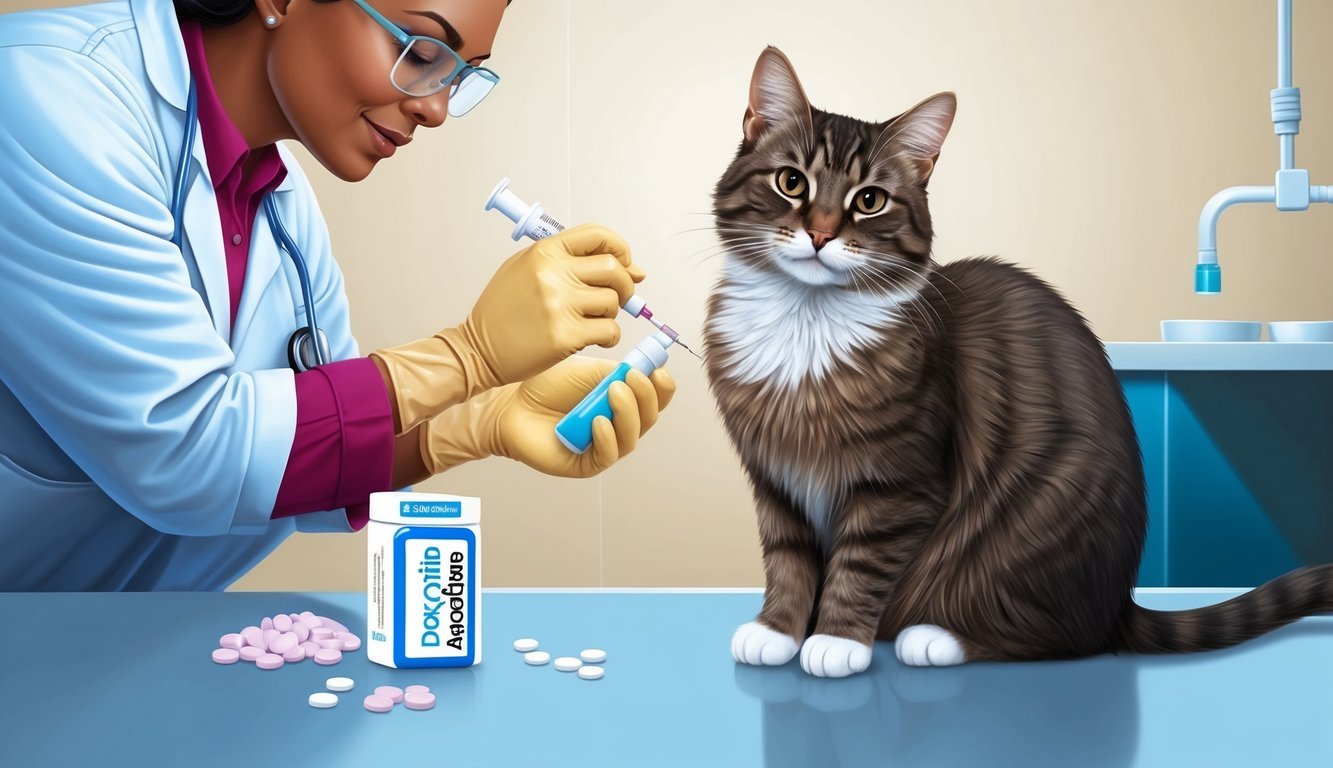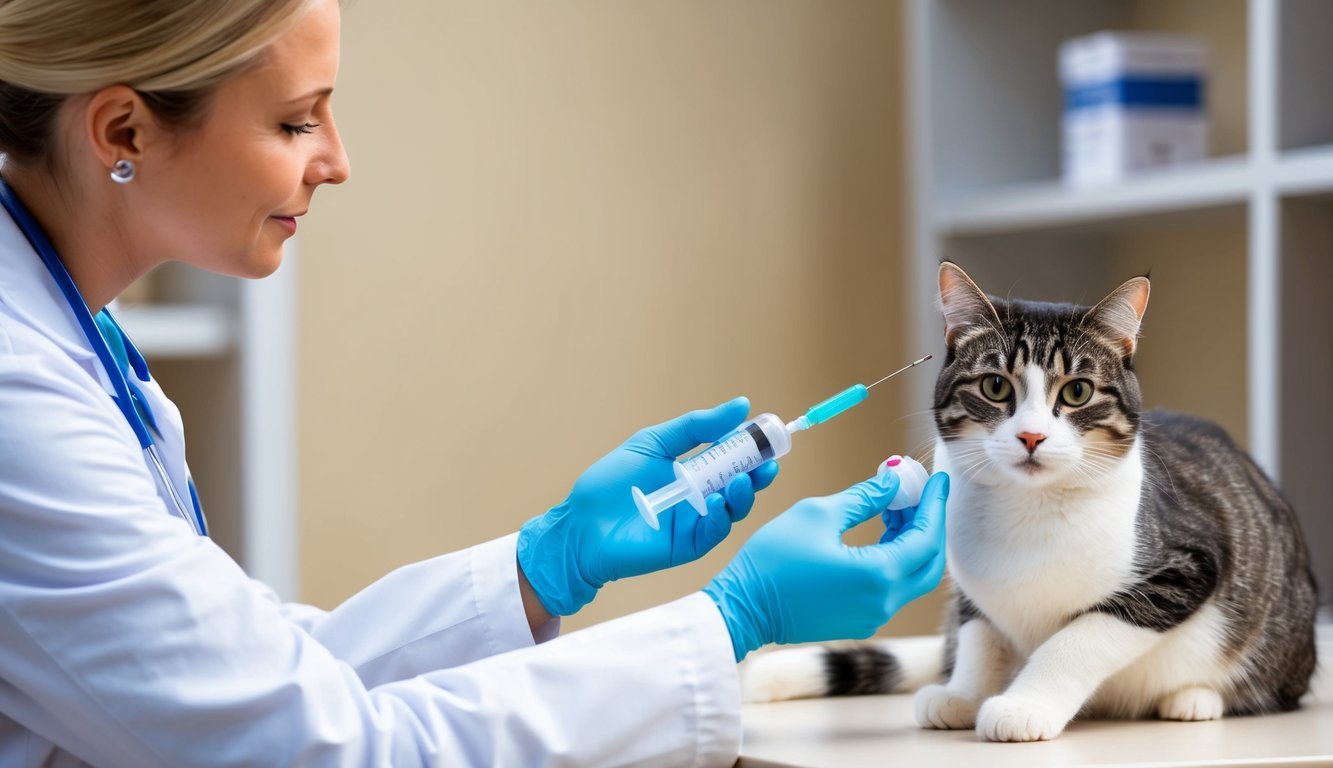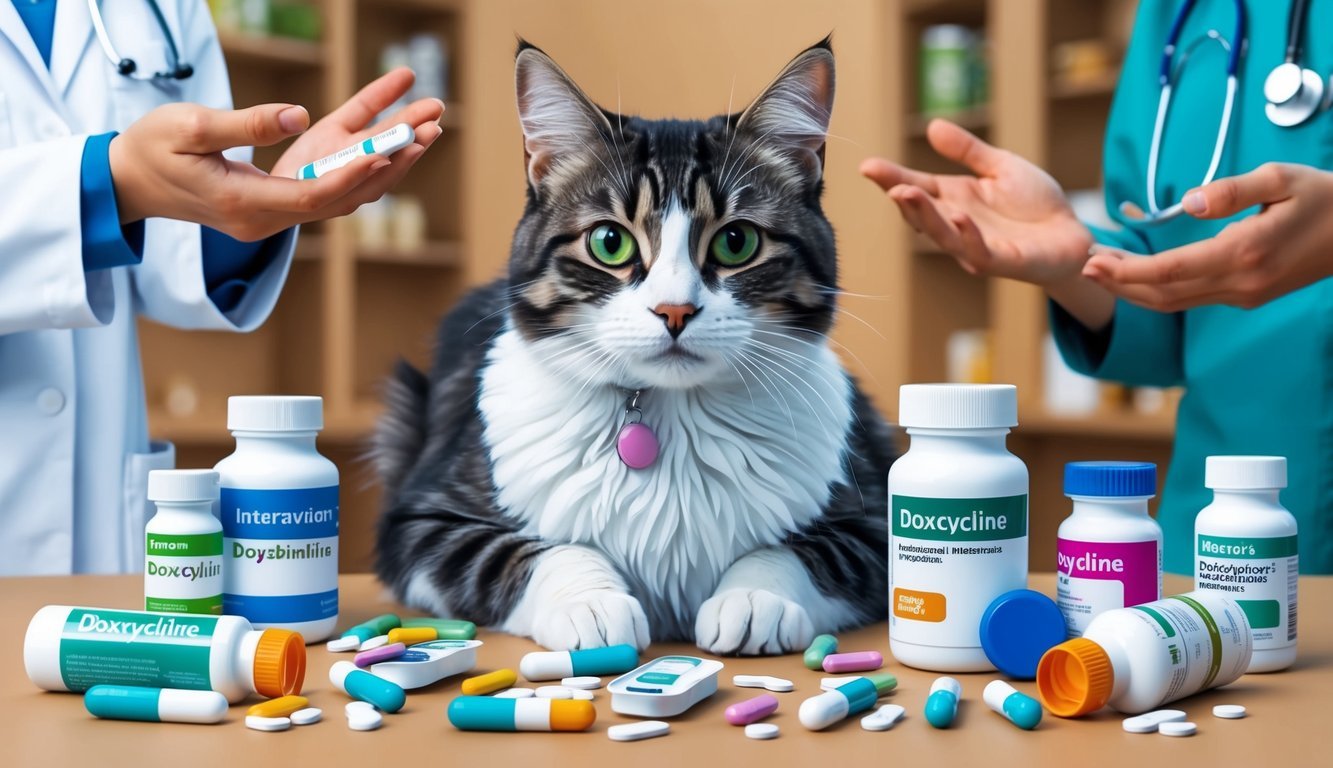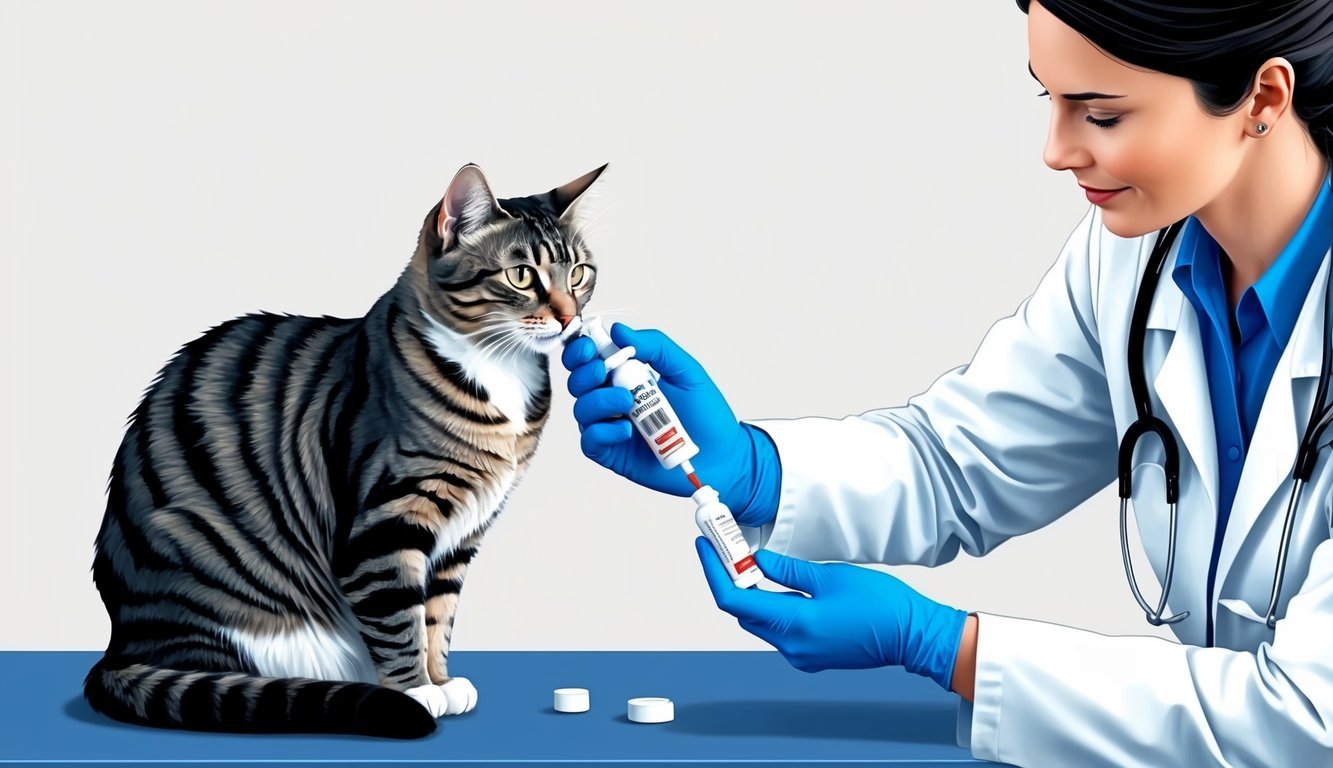Doxycycline is a widely used tetracycline antibiotic in veterinary medicine that can effectively treat a variety of bacterial infections in cats. Vets commonly prescribe this medication for conditions such as upper respiratory infections, tick-borne diseases, and infections transmitted by fleas.
Understanding how doxycycline works and the proper way to administer it is essential for ensuring your cat’s health and recovery.
When considering doxycycline for your feline friend, it’s crucial to be aware of potential side effects and interactions with other medications.
Each cat may respond differently to the treatment, making it important to follow your veterinarian’s guidance closely.
This article will provide you with essential information on using doxycycline safely and effectively.
Whether you’re dealing with a specific infection or simply want to learn more about this antibiotic, you’ll find the insights here invaluable for keeping your cat healthy and thriving.
Key Takeaways
- Doxycycline is effective against various bacterial infections in cats.
- Awareness of side effects and medication interactions is essential.
- Consult your veterinarian for the correct administration and dosage.
Understanding Doxycycline

Doxycycline is a type of broad-spectrum antibiotic that falls under the tetracycline class.
It’s commonly used to treat various infections in cats.
This section will cover what doxycycline is, how it functions, and the different preparations available.
What Is Doxycycline?
Doxycycline is a medication that targets bacterial infections in cats.
As a broad-spectrum antibiotic, it effectively combats a wide range of bacteria that can cause health issues in your cat.
It’s classified as a tetracycline antibiotic, meaning it shares similarities with other antibiotics in its group.
This medication is bacteriostatic, which means it inhibits bacterial growth rather than killing the bacteria directly.
By doing this, doxycycline helps your cat’s immune system combat the infection more effectively.
Veterinarians may prescribe doxycycline for conditions such as respiratory infections, Lyme disease, and certain skin infections.
It’s important to follow your vet’s instructions regarding dosage and duration of treatment.
How Doxycycline Works
Doxycycline works by interfering with the protein synthesis of bacteria.
By binding to the ribosomes of the bacteria, it obstructs their ability to produce essential proteins needed for their growth and reproduction.
This mechanism slows down the progress of the infection, allowing your cat’s immune system to take charge and eliminate the remaining bacteria.
It’s crucial to administer doxycycline as directed by your veterinarian.
This helps ensure effective treatment while minimizing the risk of developing antibiotic resistance.
Monitor your cat for any changes in symptoms during treatment to help gauge whether the medication is working.
If you notice any concerning side effects or lack of improvement, consult your veterinarian promptly.
Types of Doxycycline Preparations
Doxycycline is available in different forms to accommodate your cat’s needs.
The most common preparations are tablets and liquid formulations.
-
Tablets: These are typically given orally, with a recommended dosage of 2.5 mg per pound of body weight every 12 hours.
-
Liquid: This form is easier to administer for some cats and is given at a dosage of 2 ml per pound of body weight.
It’s essential to follow your veterinarian’s recommendation on which form is best for your cat.
Each preparation has its own advantages, and some cats may respond better to one type than the other.
Always ensure your cat consumes the full dosage to maximize the effectiveness of the treatment.
Uses of Doxycycline in Cats
Doxycycline is a versatile antibiotic commonly prescribed for various feline infections.
It is effective against several types of bacterial infections, making it a valuable tool in your cat’s healthcare.
Common Infections Treated with Doxycycline
Doxycycline is often used to treat upper respiratory infections in cats, which can be caused by bacteria like Bordetella and mycoplasma.
This medication targets the bacteria effectively, relieving symptoms such as coughing and nasal discharge.
It’s also beneficial for treating skin infections.
Conditions like abscesses or dermatitis can arise from bites or scratches, and doxycycline helps eliminate the underlying bacterial cause.
Finally, urinary tract infections (UTIs) can be addressed with doxycycline.
It works against the bacteria that can trigger infections, helping your cat regain comfort.
Doxycycline for Specific Feline Diseases
This antibiotic is critical in managing diseases like ehrlichiosis and anaplasmosis, both transmitted by ticks.
Doxycycline can help clear these infections and reduce symptoms in affected cats.
In case of heartworm disease, doxycycline is sometimes included in treatment plans.
It targets the Wolbachia bacteria that live in heartworms, which can help improve treatment outcomes.
Another important application is for cats infected with chlamydia.
This condition can lead to respiratory issues, and doxycycline can effectively manage the infection.
Off-Label Uses of Doxycycline
Doxycycline may be prescribed for treatment of Bartonella infections, which are often linked to flea exposure.
This can be particularly important in multi-pet households where transmission is more likely.
It’s also used for certain tick-borne diseases.
In addition to ehrlichiosis and anaplasmosis, doxycycline can help manage infections from various pathogens transmitted by ticks, keeping your cat healthier.
Administering Doxycycline to Cats

When giving doxycycline to your cat, it’s important to understand the proper dosage, available forms, and the need for monitoring during treatment.
Each of these aspects ensures that your feline friend receives the most effective care while minimizing risks.
Proper Dosage and Administration
The typical doxycycline dosage for cats is 2.5 mg per pound (5 mg/kg), administered orally every 12 hours.
This can vary based on your cat’s weight, age, and overall health.
If your cat is placed on doxycycline, always consult your veterinarian before starting.
They may adjust the dosage based on specific health conditions or concurrent medications.
Key points for administration include:
- Always use a precise measuring device.
- Administer with food to reduce the risk of gastrointestinal upset.
- Never exceed the prescribed amount, as too much can lead to toxicity.
Doxycycline Forms and Administration Methods
Doxycycline comes in several forms, including tablets, capsules, and liquid solutions.
Liquid formulations are often preferred for cats, as they help prevent esophagitis, a condition that can occur with tablet administration.
Liquid Administration:
- Generally, it’s 2 ml per pound (4 ml/kg) of body weight.
Tablet Administration:
- Tablets typically come in 100 mg doses, which may need to be compounded for your cat’s specific needs.
Remember to store doxycycline at room temperature and keep it out of reach of pets.
Also, shake liquid forms gently before use to ensure an even distribution of the medication.
Monitoring and Follow-Up Care
Monitoring your cat during doxycycline treatment is crucial.
Watch for any signs of side effects, such as vomiting, diarrhea, or loss of appetite.
If any of these occur, contact your veterinarian promptly.
Regular check-ups may be needed to assess the effectiveness of the treatment and to adjust dosages if necessary.
If your cat is on other medications, inform your vet, as doxycycline can interact with various drugs.
Keeping a close eye on your cat during and after treatment is key to ensuring their well-being.
Your veterinarian may also recommend follow-up tests to confirm the infection is clearing up effectively.
Possible Side Effects and Complications

When using doxycycline for your cat, it’s essential to be aware of the possible side effects and complications.
Understanding what to look out for can help ensure your pet’s health and well-being during treatment.
Common Side Effects in Cats
Doxycycline can cause several common side effects in cats, primarily affecting the gastrointestinal system.
You might notice your cat experiencing:
- Vomiting: This can occur soon after administration.
- Nausea: Your cat may seem less enthusiastic about eating.
- Diarrhea: This could lead to loose stools or an increase in bathroom visits.
- Lack of Appetite: Some cats may eat less than usual.
To help ease these issues, giving doxycycline with food may reduce gastrointestinal upset.
It’s also vital to monitor if these symptoms persist, as continuous vomiting or severe diarrhea can lead to dehydration.
Serious Adverse Reactions
While most cats handle doxycycline well, some may experience serious side effects.
Pay close attention to the following:
- Esophageal Stricture: This can happen if the medication gets stuck in the esophagus and causes scarring.
- Liver Failure: Uncommon but serious, signs may include jaundice or lethargy.
- Anemia: Look for signs like weakness or pale gums.
- Allergic Reactions: Symptoms may include swelling, extreme itching, or difficulty breathing.
If you notice any of these severe symptoms, it’s crucial to contact your veterinarian immediately.
Managing Side Effects and Ensuring Safety
You can take several steps to manage potential side effects and ensure your cat’s safety during treatment with doxycycline:
- Administer with Food: Helps reduce gastrointestinal upset.
- Monitor for Symptoms: Keep an eye on your cat’s behavior and appetite.
- Stay Hydrated: Ensure your cat has constant access to fresh water.
- Consult Your Veterinarian: If side effects occur, discuss alternatives or adjustments.
Being proactive can help you manage any issues that arise and keep your pet comfortable throughout the treatment process.
Always communicate with your vet about any concerns.
Interactions with Other Medications

When giving doxycycline to your cat, it’s crucial to be aware of potential interactions with other medications and certain foods.
These interactions can affect the effectiveness of doxycycline and your cat’s overall health.
Drug Interactions to Be Aware Of
Several medications can interact negatively with doxycycline, including:
- Antacids: Products containing aluminum, magnesium, or calcium can bind to doxycycline, leading to decreased absorption. It’s best to space these by at least two hours.
- Iron Supplements: Like antacids, iron can interfere with doxycycline’s absorption. Ensure these are given at different times.
- Phenobarbital: This anticonvulsant can affect the metabolism of doxycycline, potentially decreasing its effectiveness.
- Warfarin: The antibiotic may enhance the anticoagulant effects, increasing bleeding risk.
- Enrofloxacin: Using both can elevate the risk of side effects and should be approached cautiously.
- Digoxin: Doxycycline can potentially increase the levels of digoxin, leading to toxicity.
Consult your veterinarian if your cat is on any of these medications.
Food and Supplement Interactions
Food can play a role in how doxycycline works in your cat’s system.
- Oral Antacids: As previously mentioned, taking doxycycline with oral antacids can hinder absorption. Avoid giving them together to maximize the medication’s efficacy.
- Calcium-Rich Foods: High calcium in dairy products can also bind to doxycycline, which means giving it on an empty stomach is often recommended for better absorption.
Additionally, avoiding iron supplements is vital.
Many pet owners may not realize that some supplements can compromise the drug’s effectiveness.
Always check with your veterinarian before introducing or continuing any supplements while your cat is on doxycycline.
Being cautious about these interactions can help ensure your cat receives the full benefits of the medication without the risk of complications.
Special Considerations and Precautions

When considering doxycycline for your cat, it’s essential to keep in mind specific precautions that can influence its safety and effectiveness.
Factors such as pre-existing health conditions, pregnancy, and the potential for antibiotic resistance should inform your decisions.
Use in Cats with Pre-Existing Conditions
If your cat has a pre-existing condition, particularly involving the liver or gastrointestinal tract, consult your veterinarian before starting doxycycline.
Conditions like elevated liver enzymes or previous esophagitis can increase the risk of adverse effects.
Monitor your cat for signs of gastrointestinal upset, which may include vomiting, diarrhea, or decreased appetite after administration.
Adjustments to the dosage or medication may be necessary.
Also, if your cat suffers from urinary tract infections or periodontal disease, discuss alternative antibiotic treatments like amoxicillin that might be more suitable based on their health status.
Pregnancy and Doxycycline
Doxycycline is classified as a Category D drug during pregnancy, meaning it can pose risks to developing kittens.
If your cat is pregnant, discuss other treatment options with your vet.
Medications like amoxicillin may be safer choices.
Using doxycycline during pregnancy could harm the unborn kittens, leading to potential developmental issues.
Always inform your veterinarian about your cat’s pregnancy status.
Avoid using doxycycline unless it is absolutely necessary and cleared by your vet, as some infections may necessitate more careful approaches to antibiotic treatment.
Long-Term Use and Antibiotic Resistance
Long-term use of doxycycline can lead to antibiotic resistance, posing a significant concern in the treatment of bacterial infections.
This resistance can make infections harder to treat in the future.
If your cat is on a lengthy doxycycline regimen, ensure it is for a valid medical reason and monitor closely for any side effects.
Your vet may recommend periodic reassessment of your cat’s health and antibiotic needs, considering alternative treatments when necessary.
Be proactive in discussing any signs of worsening health or new symptoms that may arise during extended treatment.
This vigilance helps ensure the effectiveness of antibiotics in the long run.
Frequently Asked Questions
Doxycycline is a commonly prescribed antibiotic for cats, and you likely have several questions about its use, dosage, and potential side effects.
Here are some answers to help you understand more about this medication.
What is the appropriate dosage of doxycycline for a cat?
The dosage of doxycycline typically ranges from 5 mg to 10 mg per kilogram of your cat’s body weight.
It’s generally administered every 12 to 24 hours.
Your veterinarian will determine the specific dosage based on the type and severity of the infection.
Can doxycycline cause side effects in cats, and what are they?
Yes, doxycycline can cause side effects in cats.
Common side effects may include loss of appetite, vomiting, and diarrhea.
If you notice any unusual behavior or symptoms, it’s important to contact your veterinarian.
How long is it safe for a cat to be treated with doxycycline?
Treatment duration varies depending on the infection being treated.
Some cats may require doxycycline for as few as 5 days, while others might need it for up to a month.
Always follow your vet’s recommendations regarding the length of treatment.
What are the common uses of doxycycline in feline care?
Doxycycline is used to treat various bacterial infections in cats.
It’s effective against conditions like anaplasmosis, certain respiratory infections, and periodontal disease.
Your vet will prescribe it based on your cat’s specific health needs.
Is it possible for a cat to have an adverse reaction to doxycycline?
Yes, while not common, some cats may experience adverse reactions to doxycycline.
These can range from gastrointestinal issues to more severe allergic reactions.
If you suspect your cat is having an adverse reaction, seek veterinary care immediately.
How does the taste of doxycycline affect a cat’s willingness to take it?
Some cats find the taste of doxycycline unappealing, which can make giving them the medication challenging.
To help mask the taste, it’s often recommended to give the medication with food or a treat.
If your cat resists taking it, speak with your vet for alternative options.

